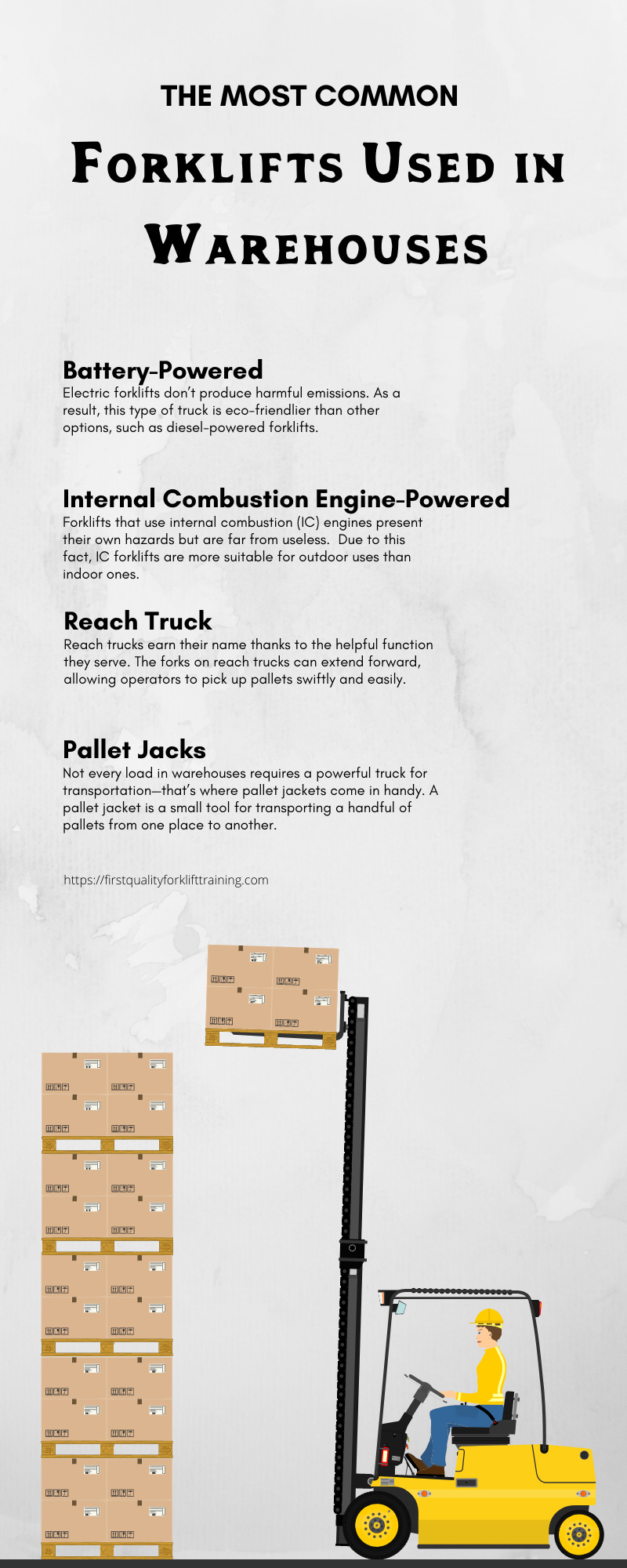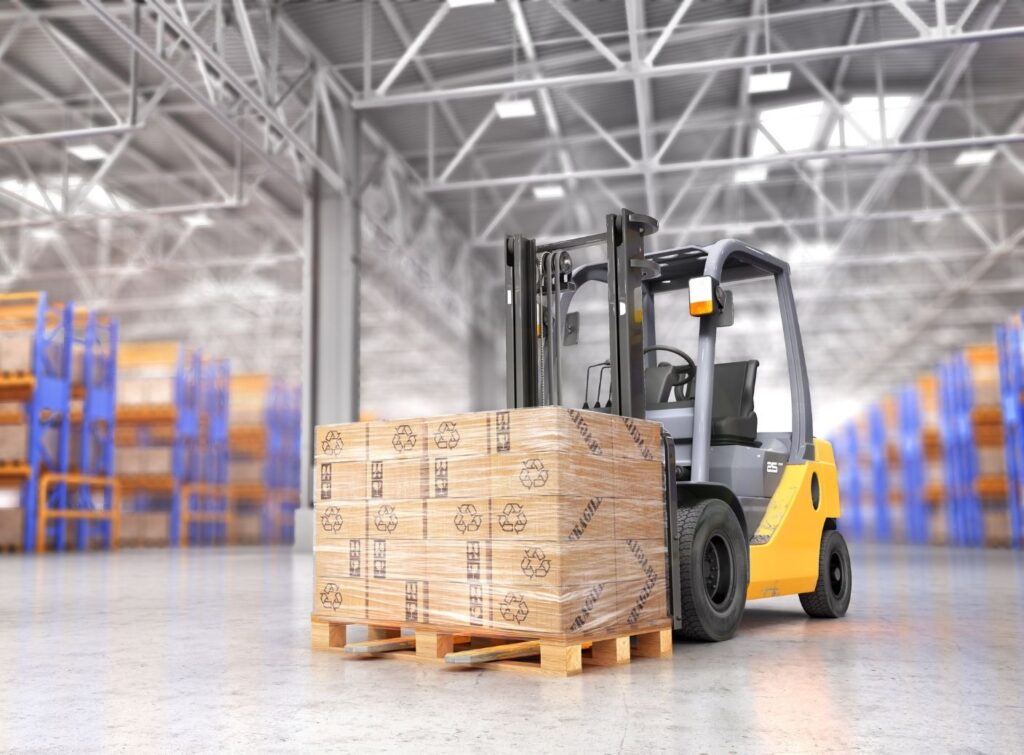Forklift Operator Training
The Most Common Forklifts Used in Warehouses
From construction sites to warehouses, forklifts function in a wide range of work environments. Finding the right forklift for any given workplace takes more than finding a reliable vendor, though that’s crucial, too. Before committing to a forklift for your business, make sure you’re privy to all the best options for your specific workplace needs.
For example, some forklifts are better for warehouse operations than others. If you’re unfamiliar with the many options available, look through this list of the most common forklifts used in warehouses. With this knowledge under your belt, finding the perfect forklift for your workplace needs will become much easier.
Counterbalance Trucks
Counterbalance trucks are the most common forklift you’ll see traveling around warehouses. These trucks (Class IV & Class V) consist of battery powered (Class I) and internal combustion engine (Class IV & Class V) are discussed in more detail below. These types of machines are so common that when the average joe hears the term “forklift,” the machine they’re likely picturing is a counterbalance truck. A counterbalance truck’s forks are at the front of the machine, while a rear-mounted weight keeps it stable during operations. As the forks pick up heavy loads, the counterweight prevents the machine from tipping over under the pressure. For even better maneuverability, warehouses can use three-wheel counterbalance trucks. Fewer wheels might sound negative, but three-wheel counterbalance trucks have a tighter turn radius, similar to that of a reach truck.
Battery-Powered
Battery-powered forklifts are one of the many forklifts functioning in warehouses each day. As you’ll learn below, batteries aren’t the only forklift fuel type, but they present great benefits for warehouse operations. For example, electric forklifts don’t produce harmful emissions. As a result, this type of truck is eco-friendlier than other options, such as diesel-powered forklifts.
Furthermore, the lack of harmful fume emissions means employees can operate electric forklifts indoors without inhaling toxic materials. Beyond their safety benefits, battery-powered trucks are a better long-term investment. Although they cost more upfront than propane or diesel-fueled options, electric forklifts cost less in the long run, thanks to their maintenance requirements. Whereas internal combustion engine forklifts require costly, thorough upkeep, electric forklifts are much easier and more affordable to maintain.
Internal Combustion Engine-Powered
Forklifts that use internal combustion (IC) engines present their own hazards but are far from useless. As mentioned above, the internal combustion engine produces harmful emissions when operational. Due to this fact, IC forklifts are more suitable for outdoor uses than indoor ones. That said, you can use them indoors for certain periods of time as long as your ventilation system is reliable enough to combat toxic fume accumulation.
One of the great attributes IC forklifts bring to the workplace is torque. Unlike its battery-powered counterpart, a truck running on an internal combustion engine has better torque, giving it the extra power it needs to work over long distances and up and down inclines successfully. If your workplace calls for forklifts to maneuver up and down inclines, using the safest option for the job is essential. If your employee tries to travel up an incline with a forklift that isn’t built for such operations, it can result in accidents such as tip-overs or collisions. Both tip-overs and collisions are common forklift accidents that are preventable with the right care and preparation.
A key factor determining where an IC forklift can function is what type of tires it has. Class IV trucks have internal combustion engines with cushion tires. Class V, on the other hand, covers forklifts with internal combustion engines and pneumatic tires.
If your forklift has cushion tires, it should only operate on even, stable surfaces. Cushion tires are made from durable rubber, but they’re vulnerable to damage from uneven terrain. Pneumatic tires offer better traction than cushion tires, making the former better at traveling over uneven surfaces. Furthermore, solid pneumatic tires exist, which contain thick rubber all the way through. As a result of having no hollow cavity for inside air, solid pneumatic tires are much less susceptible to punctures and other forms of damage.
Reach Truck
Reach trucks earn their name thanks to the helpful function they serve. The forks on reach trucks can extend forward, allowing operators to pick up pallets swiftly and easily. As you can tell from the fork flexibility, a reach truck’s main attribute is maneuverability. Electric reach trucks are class II forklifts, which designates them “electric motor narrow aisle trucks.”
As the lengthy designation insists, electric reach trucks are great for maneuvering through narrow aisles to retrieve loads. What makes reach trucks even more suitable for narrow aisles is their turn radius, which is impressively tight and accurate.
Thankfully, this means businesses can optimize space better when reach trucks are present; push aisles closer together instead of taking up excessive floor space, simple and convenient. Although reach trucks are great indoors, they won’t function properly on uneven, outdoor terrain. As long as you keep them inside and on smooth, even ground, reach trucks will keep material loading safe and efficient.
Pallet Jacks
Not every load in warehouses requires a powerful truck for transportation—that’s where pallet jackets come in handy. A pallet jacket is a small tool for transporting a handful of pallets from one place to another. Suffice it to say, this is a very straightforward tool, which makes training relatively easy, especially in comparison to more complex machines in warehouses.
A pallet jack comes in two modes—battery-powered and manual. It’s important to note that manual pallet jacks do not fall under CFR 1910.178 Powered Industrial Truck (PIT) training/certification requirements. An important fact about pallet jacks is their loading and unloading capabilities. Pallet jacks can’t lift as high as a counterbalance or narrow aisle forklift, so the former is only ideal for operations occurring entirely at ground level.
With a better understanding of the most common forklifts used in warehouses, you can ensure your business utilizes the right machines. From pallet trucks to reach trucks, forklifts help warehouses thrive. However, for the best results, ensure you’re pairing the right forklift with the right application.
Furthermore, you must ensure operators in the workplace earn certification with the help of a comprehensive forklift training package. As you know by now, there are many different forklifts and we have only scratched the surface in this blog. Each PIT needs a training course tailored to its specific attributes and specifications. Once you have a suitable forklift and training resources, you can give operators the help they need to fire on all cylinders daily.



Greetings..,
your blog article very informative.